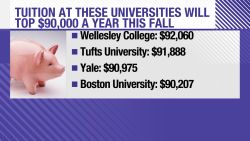In November 2016, barely a year after General Motors signed its last four-year deal with the United Auto Workers union, the problems that would lead to this week’s strike became apparent.
Auto sales were slowing. Although the industry posted its seventh straight year of improved US sales in 2016, an industry record, the increase was only 0.4%. That would prove to be the industry’s high water mark.
At GM (GM), US sales started to fall because of a 7.5% drop in the sales of car models. So GM (GM) announcedits first layoff in six years, eliminating one of three shifts at its massive Lordstown, Ohio, assembly plant, which made the Chevrolet Cruze, as well as at a plant in Lansing, Michigan that builds Cadillacs and Camaros.
The line to this week’s strike traces directly back to that layoff announcement, illustrating the very different views management and labor had about the future of the auto industry. That gap makes finding a quick conclusion of the current strike particularly difficult. Nearly 50,000 hourly GM workers are picketing in the second day of the strike.
America’s love affair with sedans is over
By 2016, Americans had already lost their long-time love for the traditional family sedan.
In some ways that was good news for the auto industry — the more popular SUV was more expensive to buy and more profitable for automakers. But it meant that the US automakers would be left with a lot of plants that once made sedans that it didn’t need. No automaker had more excess capacity in the United States than GM.
Other GM layoffs would follow, including a second shift at Lordstown.
Then in November 2018, the company dropped a bomb when it announced plans to halt production at four US plants. The Lordstown plantwould stop building the Cruze, the Impala sedan would no longer roll off the assembly line at the Hamtramck plant in Detroit, and transmissions would not be produced at factories in Baltimore and Warren, Michigan.
Meanwhile, GM was adding jobs elsewhere to build more SUVs. GM said of about 3,000 hourly workers at those four plants, it found other jobs for 2,300 of those able to relocate to other plants.Others were eligible for retirement. But workers were still angry.
“These were going to be really difficult negotiations no matter what,” said Kristin Dziczek, vice president of industry labor and economics for the Center for Automotive Research, a Michigan think tank. “But with that announcement, the union been talking tough about GM for almost a year. They’ve been saying ‘We’re going to use all our tools. We’re going to the mat.’ Taking it to the mat means a strike.”
Getting back past concessions
GM’s workers believed, with some justification, that the sacrifices they agreed to just before and during the Great Recession in 2007 and 2009 were crucial to saving the company.
During those two contracts, GM was hemorrhaging cash on its way to a federal bailout and bankruptcy in 2009. Today, however,GM’s financial position is very strong, as the past decade has been the company’s most profitable ever. Autoworkers have benefited from those profits, taking in an average of $80,000 in profit-sharing bonuses during that time, according to GM.
Many workers contend they should be able to get back some of what they conceded 10 and 12 years ago.
“A lot of things we sacrificed back during the recession in 2007 and 2008, we want to be compensated for as the company is making record-breaking profits,” said Ray Carter-Wilson. “I understand the position of the company going forward, [wanting to be] profitable and on the cutting edge of new technology….But we want to be compensated as well because we took a major sacrifice over the years.”
Big changes, new rivals for the industry
GM executives see a much bigger problem than just slowing sales and a shift away from sedans.
They believe that the industry is undergoing its biggest change in a century. They see a need to develop electric cars and self-driving vehicles, a research and development task that will cost billions of dollars, even though the vehicles produced have more long-term potential than short-term demand or profitability.
“I believe personal transportation will change more in the next five years than it has in the last 50,” CEO Mary Barra told shareholders at the annual meeting in June of 2016.
If GM doesn’t adapt, Barra believes it cold lose out to a host of new rivals, such as upstarts Tesla (TSLA) and Uber (UBER), as well as Google (GOOG) and maybe even Apple (AAPL) and Amazon (AMZN).
When it announced plant closing plans last year, GM said much of the $6 billion in hoped-for savings would go to research and development efforts for that next generation of vehicles.
Uncertainty abounds
GM also faces other uncertainties, including the global trade wars. It has warned the Trump administration that will have to cut jobs further if tariffs are imposed on imported cars and car parts.
The market for cars in China, GM’s largest market for new car sales, has plunged as the Chinese economy slowed. And regulations are in flux, including an ongoing dispute over mileage standards put in place by the Obama administration.
“You have uncertainty on every front,” said Dziczek.
In response, GM and other automakers say they need to keep their costs flexible enough to respond to changes. They want to use more temporary workers to fill openings. And they hope to pay the permanent workers with profit sharing, which fluctuates, rather than increasing base pay, which doesn’t.
GM might be willing to put some of the next generation of electric vehicle and battery production into the closed plants, but that work is years away. The union’s proposal to shift production from lower-wage Mexican factories to the idled US plants has been a non-starter for GM.
In other words, the two sides are still very far apart.
“We absolutely believe we deserve what we’re fighting for,” said Meoshee Edwards, a 22-year veteran of the Hamtramck plant, on a picket line outside the factory Tuesday. “We’re not trying to get rich. We’re just trying to provide for our families.”
Problems posed by union scandal
As if bridging the gap between rank and file and management’s view of the industry wasn’t tough enough, into this mix came a scandal that could shake member confidence in the union’s leadership.
Nine people, mostly former union officials but also some executives of automakers Fiat Chrysler, pleaded guilty to charges in a conspiracy that included misappropriation of union funds and bribery of union officials by auto executives.
Last month the FBI confirmed that its agents, along with the IRS, searched the home of UAW President Gary Jones.
And last week, the government filed charges against another union official. The criminal complaint against that official mentions other unnamed UAW officials that authorities say are involved in the scandal. A report in the Detroit News identified Jones as one of those unidentified co-conspirators.
Union officials have not commented on the news report. Terry Dittes, the UAW vice president leading negotiations with GM, said he’s not concerned about scandal coming at the same time members are walking out.
“Our focus is not on those things. Those things will take care of themselves,” Dittes told CNN Monday. “That has not affected our negotiations one bit.”
The scandal could hurt the chances of ratification of any deal reached between management and current union leadership.
“GM has no interest in having a weakened UAW. They don’t want a tentative agreement the leadership on the other side of the table can’t get ratified,” said Dziczek.
— CNN Business’ Vanessa Yurkevich contributed to this report

























